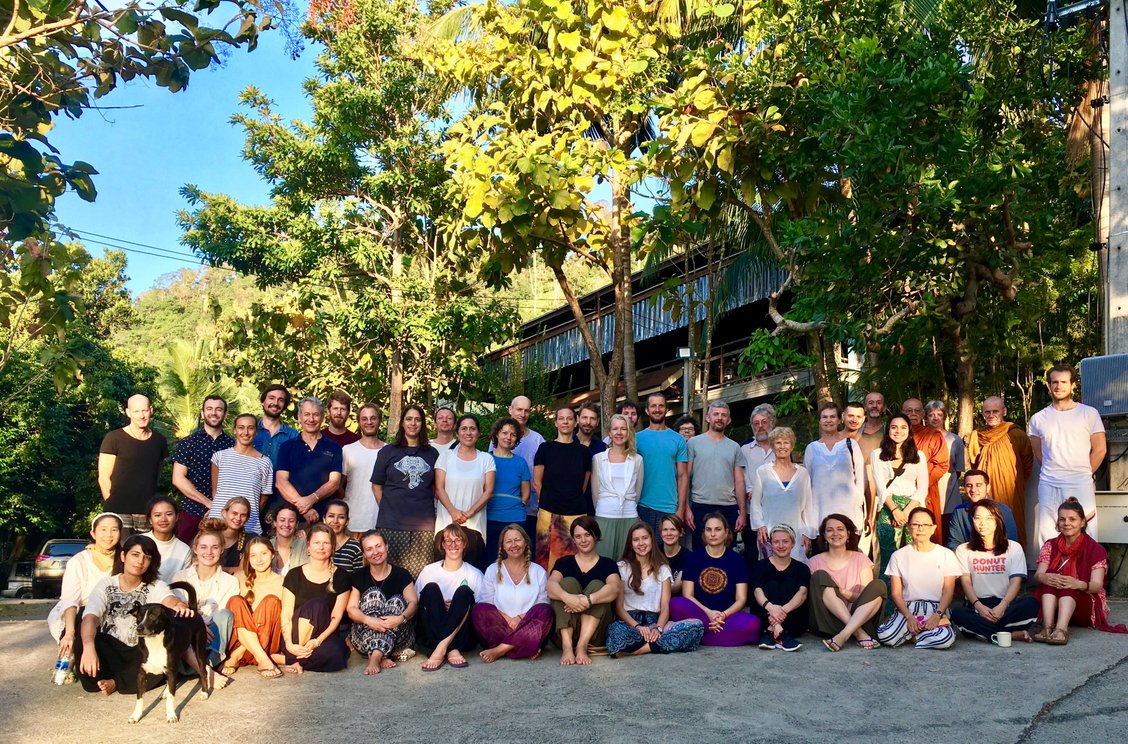Misty Mountain Healing
Account of Ralf’s experience at Dipabhāvan Meditation Retreat, Koh Samui.
At the end of the early morning meditation a guy sitting in the front row of the meditation hall shines his little flashlight at the opposite wall where the abbot is sitting. Ajahn Poh, 84 years old and quite agile, is indeed asleep, half slouched-over in meditation pose. The meditators keep sitting patiently because it is custom to wait for the monks to leave first, and only then the hour of revitalizing yoga can start. Finally the caretaker of the center shifts some furniture and Ajahn Poh awakes and gracefully walks out of the hall, leaning on his walking stick.
Sleeping is quite an experience. The male dormitories are located directly under the meditation hall, it has a wide door which is always open, and steel bars in the open windows. The bed consists of wooden planks without a mattress. The center is located in the middle of the Koh Samui jungle. There are snakes, scorpions, millipedes, centipedes (the latter ones can bite), loud frogs and carnivorous mosquitoes. The smell of anti-mosquito spray fills the meditation hall, which is completely open on all sides, and the meditators, sitting motionlessly, make easy targets for the mosquitoes. Outside a sign says : “Beware of scorpions. Walk mindfully.” At night the symphony of crickets, frogs, an insect which sounds like a circle saw, and various animals devouring each other, reaches its crescendo with the frantic snoring of some of the guys.
Thus the days go on: sitting meditation, walking meditation (quite delightful in the evening with the sun setting), chanting Buddhist texts and a one hour yoga class. There are great Thai vegetarian meals twice a day, at 9 o’clock and 12 o’clock. It is a silent retreat, so no talking for six days, no telephone, no books. There are Dharma talks by Dhamavidu Bikhu, an Englishman who has been a Theravada Buddhist monk for decades; he is very knowledgeable about the history and workings of Buddhism, and very frank with his ideas about certain practices. He says that he thinks that it must be easier to practice mindfulness outside the monastery, but then he contradicts himself and says that it is good to be a monk in order to have the time and solitude to meditate. He also shares stories about his daily life as a monk.
Compared to a Goenka Vipassana retreat where men and women are completely separated, and don’t even have eye contact, here it is more open, and as the friendly caretaker indicates, ’you can smile at someone’. One wonders who are a couple, who are friends, or what somebody is like as a person. You can learn a lot from small movements and gestures. A friendly push in the line for the yoga mats is the only contact a couple has. But apart from this, it is all about going inside. Dhamavidu Bikhu challenges the meditators by loudly saying ‘Good Afternoon!’ at the beginning of every talk, to which the group of meditators has to quench a natural reply. He talks about different desires, defilements, meta (loving-kindness), society, and teaches a meditation technique which is called anapanasati or ‘the short cut method’. At one point he says: “Buddhism has many ideas for the future of mankind, but we are living in the now.”
Things one learns at the retreat:
– Mindfulness: walking, eating, washing – everything!
– Anapanasati breathing technique, also called: The short cut method, which one can practice anytime.
– Dipabhāvan yoga routine. Surely if you do one hour of yoga everyday for the rest of your life you will always be flexible and well.
– Meta (loving-kindness) (20 minutes): yourself, a close friend/family, a benefactor, someone you don’t know (who thus represents everybody else), your enemy.
– Dharma talk about “the monkey mind”: use anapanasati breathing technique. Doubt, use long breath. Anger, difficult to work with because it lingers on so long, better to not let it happen. Desire for food, think of puke. Sexual desire for a person, think of them dissected, without skin. Negativity, visualize one or two things which make you happy.
It is possible that after a few days you realize that you can do anapanasati during sitting meditation, walking meditation and during everything else that you do that day, and that your mind is quiet. Quiet!
Many meditation masters say that it is not what happens during meditation that matters, but what happens after. How does one experience the inner and outer world when one has touched this inner peace, this connectedness, this silence? A great calm? Meeting interesting people? Things flow better? Quietness?

